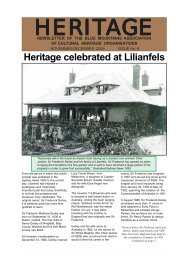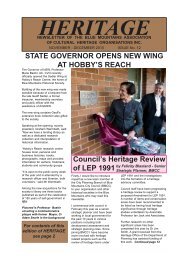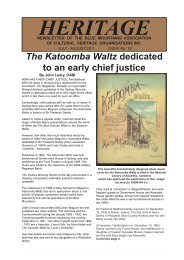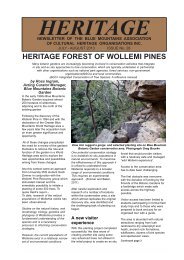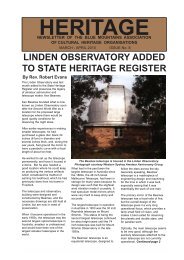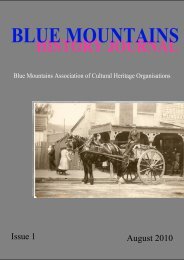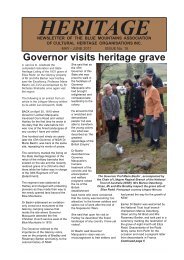‘He fought six rounds with the horse police’--- the shooting <strong>of</strong> Bold Jack DonahoeIn the current exhibition at the StateLibrary <strong>of</strong> NSW, celebrating thecentenary <strong>of</strong> the Mitchell Library,there are a number <strong>of</strong> items <strong>of</strong>interest to <strong>Blue</strong> <strong>Mountains</strong>historians among the One Hundredtreasures on display.The original journals <strong>of</strong> Blaxland,Lawson and Wentworth arefeatured as is a 1930s journal <strong>of</strong>bushwalker Myles Dunphy.by John Low, <strong>Blue</strong> <strong>Mountains</strong> Historical Society Inc.One item, however, that caught myattention, the relevance <strong>of</strong> whichmay not at first be evident, was alithograph portrait <strong>of</strong> the deadbushranger Jack Donahoeattributed to Thomas Mitchell.While Donahoe died at Bringelly,his death has a slight but interestingconnection with Wentworth Falls (orThe Weatherboard).In 1902 the Warren Heraldpublished a series <strong>of</strong> reminiscencesby Edward Readford whose father,Thomas, had been the licensee <strong>of</strong>the Weatherboard Inn during theyears 1833 to 1837.At the time, the innkeeper’s onlyneighbours were a small troop <strong>of</strong>mounted policemen housed in a‘Police Military Barrack’ opposite.Readford makes particular mention<strong>of</strong> one <strong>of</strong> these, a quiet youngScotsman named John Muggleston,who was stationed there “nearly thewhole time my father kept the hotel”and regularly frequented his father’sestablishment.Fate had given Muggleston adegree <strong>of</strong> notoriety among hisfellows.John Muggleston (also speltMugglestone, Muckelstone,Muccleston, etc.) was born ca. 1804in the Scottish agricultural andA lithograph portrait <strong>of</strong> the dead Jack Donahoecotton milling town <strong>of</strong> Neilston in theLevern Valley south <strong>of</strong> Glasgow.While nothing is known <strong>of</strong> his familyor early life other than that he hadworked as a groom, by thebeginning <strong>of</strong> 1827 he had travelledsouth into England and had takenthe king’s shilling, joining the 39 th(Dorsetshire) Regiment at Coventry.His decision to become a soldierwould take him even further fromhis birthplace for, in June 1827, the39 th Regiment embarked as part <strong>of</strong>the convict guard on board the‘Champion’ and arrived in Sydney alittle over four months later.Following a twelve month tour <strong>of</strong>duty in <strong>No</strong>rfolk Island, Mugglestonjoined the mounted police in March1829.The mounted police had beenestablished by Governor Brisbanein 1825 in response to a generalincrease in bushranging activities, astate <strong>of</strong> affairs that continued toworsen under his successor,Governor Darling.Its principal role was to combat thisand to pursue escaped convictswho contributed mightily to themembership <strong>of</strong> the bushranginggangs.In these early years the mountedpolice had a strong militarycharacter, its <strong>of</strong>ficers and menbeing volunteers seconded from theregiments garrisoned in the colonyand generally returning when thesewere transferred elsewhere.Their uniform also reflected themilitary connection with ‘full dress’resembling the 14 th Light Dragoons,though their ‘bush uniform’ includeda cabbage-tree hat along with thepatrol jacket and trousers.They were armed with a sabre,carbine and horse pistols. By 1830there were about <strong>10</strong>0 mountedpolicemen in the colony.One <strong>of</strong> the most troublesomebushrangers operating at the timeMuggleston joined the ‘horse police’was a young Irish convict escapeewho, following a conviction forhighway robbery on the Sydney-Windsor Road, had dramaticallyavoided the hangman and fled intoto the bush.This was the “wild colonial boy, JackDonahoe by name” whosedepredations and continuedevasion <strong>of</strong> the authorities in theHawkesbury-Nepean and otherdistricts around Sydney werenotorious.In the repressive climate <strong>of</strong>Darling’s administration JohnDonahoe (sometimes speltDonohoe) was rapidly becomingsomething <strong>of</strong> a folk hero among the‘lower orders’ <strong>of</strong> society.Born in Dublin ca. 1806, details <strong>of</strong>Donahoe’s early life and family areas vague as those <strong>of</strong> his Scottishcontemporary.Continued page 5HERITAGE 4July- August 20<strong>10</strong>
The shooting <strong>of</strong> <strong>of</strong> bushranger, Jack DonahoeContinued from page 4A couple <strong>of</strong> years younger thanMuggleston, he was sentenced totransportation for life in 1823 afterbeing found guilty <strong>of</strong> “intent tocommit felonry”, a rather vaguecharge that has been interpreted bysome to refer to ‘political’ crimes.As the child <strong>of</strong> a country exploitedeconomically and repressedpolitically, he had good cause todislike the English. Donohoe arrivedin Australia on board the ‘Ann andAmelia’ in early 1825, not longbefore Brisbane’s departure and theadvent <strong>of</strong> Governor Darling.In 1830 Muggleston’s commanding<strong>of</strong>ficer and fellow Scot, LieutenantLachlan McAlister, devised a newstrategy for his mounted police unitbased at Goulburn.Instead <strong>of</strong> the usual reactionarypursuit from place to place, allowingthe villains greater options forescape, his troopers now conductedregular and systematic patrols <strong>of</strong>the known haunts <strong>of</strong> the Donahoegang. It was a good plan and onWednesday, September 1, 1830, itbrought results.As an early spring evening settledon the Bringelly bush, Mugglestonand six other troopers unsaddledtheir horses and prepared to makecamp.In the dusk they spied, somedistance away, three men ridingslowly through the trees leading apackhorse.These were soon identified asDonahoe, William Webber andJohn Walmsley.At the later inquest Mugglestondescribed the situation: “Thebushrangers were in a hollowsurrounded by bush, by whichmeans they were prevented fromobserving our approach.When Donahoe saw us he took hishat <strong>of</strong>f, and waved it three times,threw it in the air, and bid usdefiance ...” Both sides took coverand the bushrangers, with areckless confidence borne <strong>of</strong> theirearlier successes, began tauntingthe troopers with insults,obscenities and shooting.What followed was described indetail in the Sydney Gazette:“Muggleston, who is reckoned one<strong>of</strong> the best shots, kept his eyesteadily fixed on Donahoe, andwhen the latter peeped from behindhis tree, shewing (sic) only his headand part <strong>of</strong> his breast, the warysoldier took aim, fired, and though ahundred yards distant, in less thana minute the vaunting hero was ineternity.”The ‘troublesome’ Jack Donahoewas dead but his memory wouldfuel a legend and inspire numerouspopular ballads that circulatedthroughout Australia and overseasin places as diverse as Ireland,England, the USA, Canada, <strong>No</strong>vaScotia and Newfoundland.His nemesis, the young Scottishsoldier, on the other hand, slippedquietly into obscurity.Prior to his transfer to TheWeatherboard, there are referencesto Muggleston’s involvement inskirmishes with bushranging gangsin the Oberon area and near theFish River (Jenolan) Caves in 1831.He clearly preferred the life <strong>of</strong> amounted trooper to that <strong>of</strong> a footsoldier and twice transferred toother regiments (the 4 th in 1832 andthe 80 th in 1837) in order to remainin Australia.By the end <strong>of</strong> the 1830s he wasstationed at Newcastle and wasprobably involved in the pursuit <strong>of</strong>the ‘Jew Boy’ Gang (led by EdwardDavis, the only Jewish bushrangeron record) who were operatingthroughout the Hunter regionbetween 1839 and the end <strong>of</strong> 1840.John Muggleston died in NewcastleHospital on January 13, 1841 at theearly age <strong>of</strong> 37 and was buried inthe Christ Church CathedralCemetery. I have not, however,been able to establish the cause <strong>of</strong>his death.His colleagues in the mountedpolice erected a substantialheadstone to his memory and, whileno longer marking the spot wherehis body lies, this still exists.On its face are inscribed the words:“Sacred to the memory <strong>of</strong> JohnMuggleston who died January 1841aged about 40 years. This stone iserected by the <strong>of</strong>ficers, noncommissioned<strong>of</strong>ficers and troopers<strong>of</strong> the Mounted Police Force”.REFERENCES[Anonymous] ‘Death <strong>of</strong> Donahoe’,Sydney Gazette, September 4, 1830.Gibbney, H.J. & Smith, Ann G. ABiographical Register 1788-1939: <strong>No</strong>tesfrom the Name Index <strong>of</strong> the AustralianDictionary <strong>of</strong> Biography, Volume 2, L-Z.Canberra: ADB, 1987.MacAlister, Charles. Old PioneeringDays in the Sunny South. Goulburn,NSW: Chas. MacAlister BookPublication Committee, 1907.Meredith, John. The Wild Colonial Boy:Bushranger Jack Donahoe, 1806-1830.Ascot Vale, Victoria: Red Rooster Press,1982.Readford, Edward. ‘Reminiscences <strong>of</strong>Early Days’, Warren Herald, 2 August,1902. [Copy held in the files <strong>of</strong> the <strong>Blue</strong><strong>Mountains</strong> Historical Society]Ward, Russell. ‘Donohoe, John (Jack)(1806?-1830)’, Australian Dictionary <strong>of</strong>Biography, Volume 1. Melbourne: MUP,1966.Information supplied by the LocalStudies Librarian, Newcastle RegionLibrary [Letter dated 9 January 2003]MOUNTAIN MURDERSGlenbrook & District HistoricalSociety Inc. will conduct a walk“The Mountain Murders – LeeWeller’s Grave” on Saturday,August 28.For further detailspplinden@yahoo.com.auNATIONALTRUST WALKThe <strong>Blue</strong> <strong>Mountains</strong> Branch <strong>of</strong>National Trust is organising a walkon the lower <strong>Blue</strong> <strong>Mountains</strong>eastern escarpment for Saturday,July 24.The walk will visit Elizabeth’sLookout, Knapsack Gully andrailway viaduct built in 1867, thentraverse the original Lapstone Zig-Zag, cross the portal <strong>of</strong> theoriginal Lapstone Hill railwaytunnel, the subject <strong>of</strong> ArthurStreeton’s painting ‘Fires on’.Morning tea and lunch will beprovided.For further enquiries RhonaLeach 4757 2424.HERITAGE 5July- August 20<strong>10</strong>




